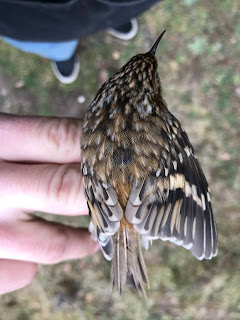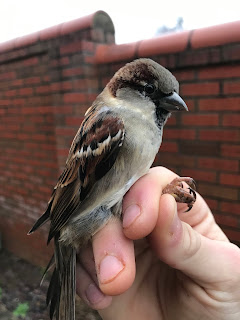Ringing through January and February is often a test of
endurance as much as it is excitement. Although we had a taste of unseasonably
warm weather this week, many of our sessions over the last two months have been
frosty affairs. As is usually the case with winter ringing for UEARG, the bulk
of our ringing has taken place on campus and as winter has progressed the
proportion of retraps in our sessions has continued to increase. A nice sign
that we have achieved good coverage of the resident populations.
The usual bunch have been mostly out at the two sites on
campus (the greenhouses and rabbit enclosure), and data collection has
progressed well for the two dissertation project students looking at parasite
load in finches and tits. Jen even had the fun of showcasing ringing to
prospective students during the recent University open days, a great opportunity to share what we
do and hopefully inspire some future ringers.
We have also had some of our C and A permit holders ringing
in their respective gardens around Norwich and a bit of extra ringing at other
sites such as Whitlingham. As a bit of a change from mist netting (our most
commonly used catching technique in the group) Kirsty and myself (Stephen) have
also done well with potter traps over the last couple of months in our tiny
Norwich garden, catching 38 birds in just two traps usually run for an hour or
so before work in the mornings.
As a group we have caught 617 birds across 25 species
over the last two months. Tits dominated the totals making up 69.4% of what we caught but highlights included some more notable species like Black-headed Gulls, Collared Doves, Common Snipe, Treecreepers, Collared Doves, and more.
Table 1. Overview of birds caught by UEARG between January
01st and March 1st 2019.
Species
|
New
|
Recaptures
|
Grand Total
|
Black-headed
Gull
|
4
|
0
|
4
|
Blackbird
|
32
|
9
|
41
|
Blue Tit
|
86
|
124
|
210
|
Canada Goose
|
0
|
1
|
1
|
Chaffinch
|
9
|
1
|
10
|
Coal Tit
|
3
|
13
|
16
|
Collared Dove
|
2
|
0
|
2
|
Dunnock
|
9
|
17
|
26
|
Goldcrest
|
0
|
1
|
1
|
Goldfinch
|
9
|
3
|
12
|
Great Spotted
Woodpecker
|
0
|
3
|
3
|
Great Tit
|
66
|
103
|
169
|
Greenfinch
|
6
|
1
|
7
|
Greylag Goose
|
0
|
1
|
1
|
House Sparrow
|
4
|
1
|
5
|
Lesser Redpoll
|
6
|
0
|
6
|
Long-tailed
Tit
|
15
|
18
|
33
|
Mute Swan
|
2
|
11
|
13
|
Robin
|
19
|
21
|
40
|
Snipe
|
3
|
0
|
3
|
Song Thrush
|
1
|
1
|
2
|
Starling
|
4
|
0
|
4
|
Treecreeper
|
2
|
0
|
2
|
Woodpigeon
|
2
|
0
|
2
|
Wren
|
2
|
2
|
4
|
Grand Total
|
286
|
331
|
617
|
I have also had some personal success with a couple of nice
species. The first is snipe on a local marsh site, where I have caught three. A
tricky site to work but hopefully with more experience of the site catching rates
will improve next season. The second is black-headed gulls of which I have
caught four. I haven’t got out trying for these as much as I had hoped, but I’m
hoping to increase effort soon.
Lots to keep us busy over the next couple of months. Nest
box season is right around the corner, and summer migrants will be here before
we know it.
One of two Treecreepers caught on campus in the last two months.
A male House sparrow, a species in UEARG that we usually only catch in our gardens as this one was.
This particular Blackbird was a bit of a monster of a specimen with a 145mm wing compared to the BTO average male wing length of 133mm, an indication this individual is likely from the continent.
One of two Collared Doves ringed in the past two months. A species caught less often than you might expect (Only 499 fully grown individuals caught across Britain & Ireland in 2017).
Nice top catch a couple of Woodpigeons, as their large size means they don't often stay in mist nets.
Common Snipe.
Black-Headed Gull.
Chaffinch
Goldfinch
Long-Tailed Tit
Starling












